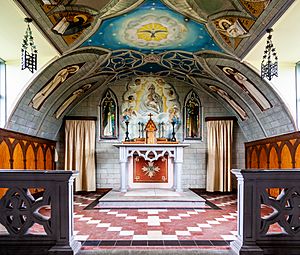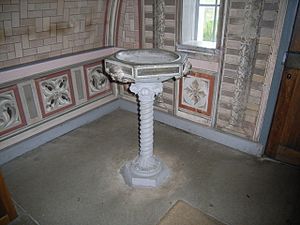Italian Chapel facts for kids
The Italian Chapel is a beautiful Catholic chapel found on Lamb Holm, a small island in the Orkney Islands of Scotland. It was built during World War II by Italian prisoners of war. These prisoners lived on the island, which was empty before they arrived. Their main job was to build the Churchill Barriers, which were causeways (like bridges) to protect the naval base at Scapa Flow.
The chapel was not fully finished until after the war ended. It has been repaired and made beautiful again several times, in the 1960s and 1990s. Today, it is a very popular place for tourists to visit. It is also a special "category A" listed building, meaning it's very important historically. The chapel is part of the Roman Catholic Church in Orkney. Church services are still held there on the first Sunday of summer months, from April to September.
Contents
How the Chapel Was Built
Prisoners of War in Orkney
About 550 Italian prisoners of war were brought to Orkney in 1942. They had been captured in North Africa during World War II. Their main task was to build the Churchill Barriers. These were four large causeways that helped block access to Scapa Flow, a very important naval base. Around 200 of these prisoners lived at Camp 60 on Lamb Holm island.
A Place for Worship
In 1943, Major Thomas Pyres Buckland became the new leader of Camp 60. He and Father Gioacchino Giacobazzi, the camp's Catholic priest, agreed that the prisoners needed a place to worship. So, they decided to build a chapel.
Creative Construction
The prisoners built the chapel using simple materials. They used two Nissen huts, which are like large metal sheds, joined together. They covered the wavy metal inside with plasterboard to make the walls smooth. The altar and the rail around it were made from concrete left over from building the barriers.
Much of the chapel's amazing interior decoration was done by Domenico Chiocchetti. He was a prisoner from a town called Moena. Domenico painted the main altar area, and other prisoners helped decorate the rest of the inside. They even built a concrete front for the chapel. This made the simple hut look like a proper church. Even the light holders were made from old corned beef tins! The font, used for baptisms, was made from a car exhaust pipe covered in concrete.
When most of the prisoners were set free just before the war ended, Domenico Chiocchetti stayed behind. He wanted to finish decorating the chapel, which had just been made a holy place.
Keeping the Chapel Special
Restoring a Masterpiece
In 1958, a group of people from Orkney created the Chapel Preservation Committee. Their goal was to protect and care for the chapel. In 1960, Domenico Chiocchetti returned to Orkney to help restore his beautiful artwork. He came back again in 1964 with his wife, Maria. Sadly, he was too ill to travel when other prisoners returned in 1992. They came to remember the 50th anniversary of their arrival on the island. Domenico Chiocchetti passed away in 1999.
A Symbol of Friendship
In 1996, officials from Orkney and Domenico Chiocchetti's hometown of Moena signed a special declaration. This showed the strong connection and friendship between the two places.
The Italian Chapel is still used for church services today. It remains a very popular place for visitors, with over 100,000 people coming each year. It has become a well-known symbol of peace and friendship in the British Isles.
Recent Work and Celebrations
In 2014, a special church service was held at the chapel to celebrate its 70th anniversary. During this service, Angela Chiocchetti, Domenico's daughter, sang a beautiful song called Panis angelicus.
In 2015, an art restorer named Antonella Papa offered to help. She restored the chapel's frescoes (wall paintings). She spent a month working on them and continued this important work with local volunteers in 2017.
Images for kids
-
War memorial, including a statue of Saint George, outside the chapel
See also
 In Spanish: Capilla Italiana para niños
In Spanish: Capilla Italiana para niños
- Pietermaritzburg Italian P.O.W. Church







